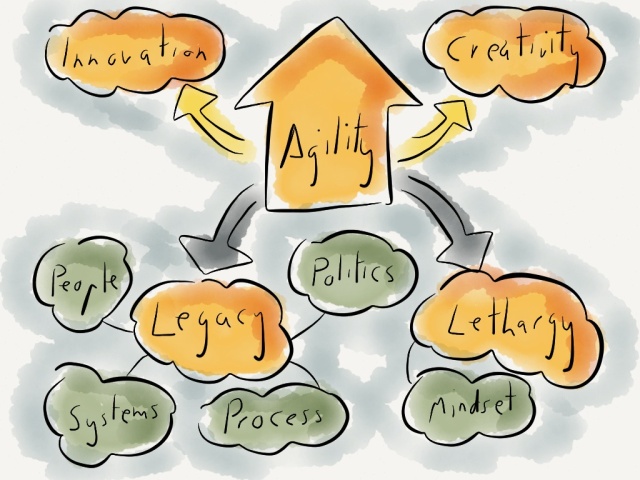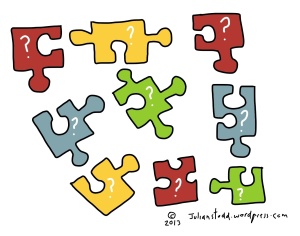Only agile organisations will thrive in the Social Age, but the barriers to agility are multifold. Some attitudinal, some technical, some about capability and competence. Innovation and creativity are strangled by legacy and lethargy. But we don’t have to live in the same space we settled in: we can make improvements, we can change.

We need to be agile, but agility is dragged down by legacy and lethargy. People, processes, technology and politics can all play a part in this. It’s about mindset.
One of the businesses i work with is ditching their Exchange server and switching to Gmail. Why? Because it just works. There are a hundred reasons not to do it, but the bottom line is that they’re all driven by people, politics and process: in our social lives, gmail does the job, so why not see if it works at work too?
Our environment is fluid: technology changes around us, the market evolves, attitudes shift, but we don’t always keep up. As the consequences of the Social Age come ever clearer (a shifting relationship between organisations and employees, an increasing reliance on personal networks, the need for constant curation of our reputation and social spaces) organisational thinking can struggle to keep up.
In a world where ‘command and control‘ is no longer effective, we still seem to devote an awful lot of time to ensuring the status quo. In a world where your reputation and authority will be based increasingly on your ability to share and support, we still attach a lot of meaning to hierarchy. In a world where social spaces are where your reputation is forged, we still attach a great deal of status to physical offices.
 To be agile, we need to look at our people, at our processes, at our technology and at the politics. And we need to be willing to change those things that face inwards, those traits that are anchored in the old age. We need to be ready to change.
To be agile, we need to look at our people, at our processes, at our technology and at the politics. And we need to be willing to change those things that face inwards, those traits that are anchored in the old age. We need to be ready to change.
We need to determine if our mindset is about agility or if it’s focussed somewhere else. Manifestations like a lethargy around technology are just by products of an outdated mindset. If you have to think whether a ‘Bring Your Own Device‘ approach is right, you’re two steps behind the curve.
The Social Age will be won by organisations that exhibit different trends: they are excellent at piloting new ideas, creating spaces for experimentation, being willing to make mistakes and effective at narrating their successes. They will recognise the power of community and be engaged within it, on the terms of the community. Their brand will be all the stronger because of that. They will nurture and attract social leaders, because social leaders exhibit agile traits: they share, they curate, they filter, they are humble, they are technically savvy, they are curious, they deliver return on investment and return on expectation.
Innovation and creativity do not just happen: they need to break free from the constraints of lethargy and a legacy of command and control.
My example around email is not fair: young, small organisations can easily be agile, they simply haven’t yet codified their thinking into process, they haven’t had time for hierarchies to emerge or politics to come into play. But we can still learn from them. There is a tipping point: when every change is burdened by a legacy, when every decision is contested, but not debated and made, that’s when your ability to be agile is being swamped by politics, by people, technology and process. That’s when you have to start fighting, to change your perspective.


Very true… Can you elaborate a bit on “organizations… [be] effective at narrating their successes”?
Hey David, sure, i am very keen on using individual and group narratives to capture/benchmark learning.
Individual narratives may be through a diary, a blog, Twitter etc, whilst within Social Learning, they may be created by the group. If this is the case, a role of the moderator is to help draw this together (in this model, it’s the third stage)
The group narratives created in social learning spaces are co-created, a theme i’m expanding in my next book on ‘music in learning – the co-creation of meaning’ (i can email you draft copy if interested – i’d welcome your feedback).
So narrating success is about individuals charting individual development (how have you changed in the last year) and about organisations facilitating the co-creation of meaning).
Thank you Julian. Very interesting indeed… And yes, I’d certainly be interesting in a draft of your next book!
Hi Julian, great post – and really extremely relevant to me at the moment. I’m pretty much in the organisation you describe in your last paragraph: a government org with a deeply embedded comand & control culture, where the hierarchy rules, where “every change is burdened by a legacy…every decision is contested, but not debated and made…your ability to be agile is being swamped by politics, by people, technology and process.” (really couldn’t have said it better myself!). Rather, I should say “WAS”: the organisation has just undergone a massive restructure and there is talk of change and wanting to drive innovation, cut beaurocracy, streamline processes, and to do things better. I don’t know that the command and control culture will disappear, but it’s an interesting time.
It will be interesting to see whether the promise of change translates to reality. I suspect that there we will still need to fight to enact change, but perhaps not quite as hard as before: that would be some progress, at least. Time will tell!
What your describing seems to be a recurrence in business, especially in the last little while, with the major changes that are occurring, largely brought about by the mass exodus of retirees and new entry of “fresh, younger blood”, as well as the increased competitiveness of globalization…
If possible, It’d be great if you could keep us abreast of the evolution of your “environment”… 🙂
Pingback: The Social Business | Julian Stodd's Learning Blog
Pingback: A six stage methodology for learning. Part 3 – Demonstration | Julian Stodd's Learning Blog
Pingback: Legacy, lethargy, and the need to be #agile | A...
Pingback: A methodology for learning. Part 5 – Reflection | Julian Stodd's Learning Blog
Pingback: A methodology for learning. Part 6 – Assessment | Julian Stodd's Learning Blog
Pingback: A methodology for learning. Part 7 – Footsteps | Julian Stodd's Learning Blog
Pingback: The narrative of authentic change in the Social Age | Julian Stodd's Learning Blog
Pingback: Narrative | Julian Stodd's Learning Blog
Pingback: Social Lives | Julian Stodd's Learning Blog
Pingback: Denied: outdated models of authority and control in the Social Age | Julian Stodd's Learning Blog
Pingback: Exploring the Social Age of learning | Julian Stodd's Learning Blog
Pingback: Collaboration and the proliferation of ideas | Julian Stodd's Learning Blog
Pingback: The 1st Dimension of Social Leadership: Narrative in the NET model | Julian Stodd's Learning Blog
Pingback: Running in the rain: risk and reward in learning | Julian Stodd's Learning Blog
Pingback: The 3rd Dimension of Social Leadership: Technology | Julian Stodd's Learning Blog
Pingback: Changing culture: evolving values and needs in the Social Age | Julian Stodd's Learning Blog
Pingback: Creating the Social Age: organisational and individual responsibility | Julian Stodd's Learning Blog
Pingback: Balance and trust: working out loud | Julian Stodd's Learning Blog
Pingback: As worlds collide: formal and informal spaces in the Social Age | Julian Stodd's Learning Blog
Pingback: Uncertainty is the only constant | Julian Stodd's Learning Blog
Pingback: The narrative of social leadership | Julian Stodd's Learning Blog
Pingback: On the second day of Christmas Learning: speed | Julian Stodd's Learning Blog
Pingback: Formal and Informal sharing in the Social Age | Julian Stodd's Learning Blog
Pingback: The ecosystem of the Social Age: working, learning and engagement | Julian Stodd's Learning Blog
Pingback: Relics of greatness: agility and learning | Julian Stodd's Learning Blog
Pingback: Perpetual beta: Learning about Learning Technology | Julian Stodd's Learning Blog
Pingback: Reputation in Social Leadership: a first draft | Julian Stodd's Learning Blog
Pingback: The gamble of talent management | Julian Stodd's Learning Blog
Pingback: Agile working: baby not required | Julian Stodd's Learning Blog
Pingback: Consensual authority in Social Leadership: formal and social spaces | Julian Stodd's Learning Blog
Pingback: The illusion of permanence in an age of change | Julian Stodd's Learning Blog
Pingback: Assailing the Castle of Resistance | Julian Stodd's Learning Blog
Pingback: Unleashing Creativity: getting fit for the Social Age | Julian Stodd's Learning Blog
Pingback: Culture, Motorbikes and Agility: Fit for the Social Age | Julian Stodd's Learning Blog
Pingback: The Social Leadership Handbook: launching today! | Julian Stodd's Learning Blog
Pingback: Building a culture of sharing | Julian Stodd's Learning Blog
Pingback: Framework for Fairness: A model for fair decision making in business | Julian Stodd's Learning Blog
Pingback: Democratised Access: Ditching the Fax | Julian Stodd's Learning Blog
Pingback: The Future of Organisations: scaffolded & reconfigurable | Julian Stodd's Learning Blog
Pingback: Disruption: Catalyst of the Social Age | Julian Stodd's Learning Blog
Pingback: To Simple, Through Complexity | Julian Stodd's Learning Blog
Pingback: From Aspiration to Culture: the erosion of values | Julian Stodd's Learning Blog
Pingback: 3 Organisational Change Curves: Dynamic, Constrained, Resisted | Julian Stodd's Learning Blog
Pingback: Eat. Sleep. Change. Repeat. | Julian Stodd's Learning Blog
Pingback: Reflections on Learning Technologies 2016: Infrastructure and Lethargy | Julian Stodd's Learning Blog